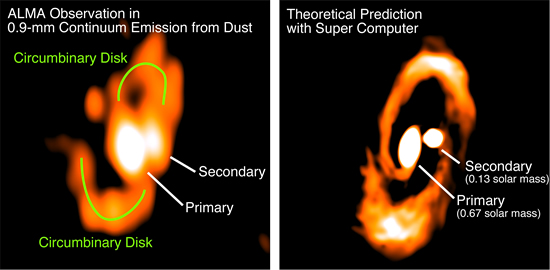|
圖片來源: Shigehisa Takakuwa

0.9-mm dust-continuum image of the protostellar binary L1551 NE observed with ALMA (left), and that predicted from our supercomputer numerical simulation (right). Green curves in the left panel traces the observed structures of the circumbinary spirals (Takakuwa et al. 2014, ApJ, 796, 1).
|
| L1551 NE is a protostellar binary (baby twin stars) located in the L1551 region at a distance of 140 pc. We have conducted the ALMA Cycle 0 observation of L1551 NE in the continuum emission originated from interstellar dusts at a 0.9-mm wavelength, and C18O molecular emission, which can be used to study gas motion with the Doppler Effect. The left panel in the above figure shows the observed 0.9-mm dust-continuum image of L1551 NE. We found a component associated with each binary star (central two components), and the circumbinary disk with a radius of ~300 AU. The circumbinary disk consists of a southern U-shaped feature and northern emission protrusions pointing to the northwest of the secondary star and northeast of the primary, and the emission minima to the north and south-east of the primary star. To interpret these observed features, we performed super-computer numerical simulations of the circumbinary disk in L1551 NE, shown in the right panel. In this theoretical image two spiral arms in the circumbinary disk are clearly seen. Comparison between the observed (left) and theoretical images (right) shows that the observed U-shaped feature to the south, emission protrusions to the northwest and northeast, and the emission minima are consistent with the theoretically-predicted spiral-arm features.
In the observed C18O molecular emission we identified infalling gas motion passing through the spiral arms toward the protostellar binary. The identified gas motion shows ongoing feeding process of the materials to the protostellar binary. These observational results unveil, for the first time, the mechanism of the birth and growth of binary stars (Takakuwa et al. 2014, ApJ 796, 1). |
 asiaa.sinica.edu.tw 媒體連絡: epo
asiaa.sinica.edu.tw 媒體連絡: epo asiaa.sinica.edu.tw
asiaa.sinica.edu.tw